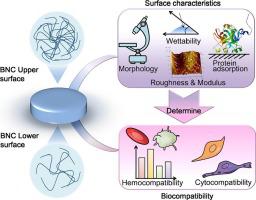当前位置:
X-MOL 学术
›
Carbohydr. Polym.
›
论文详情
Our official English website, www.x-mol.net, welcomes your feedback! (Note: you will need to create a separate account there.)
Effects of heterogeneous surface characteristics on hemocompatibility and cytocompatibility of bacterial nanocellulose
Carbohydrate Polymers ( IF 11.2 ) Pub Date : 2024-03-15 , DOI: 10.1016/j.carbpol.2024.122063 Lulu Lin , Lin Chen , Genqiang Chen , Changrui Lu , Feng F. Hong
Carbohydrate Polymers ( IF 11.2 ) Pub Date : 2024-03-15 , DOI: 10.1016/j.carbpol.2024.122063 Lulu Lin , Lin Chen , Genqiang Chen , Changrui Lu , Feng F. Hong

|
The surface properties of cardiovascular biomaterials play a critical role in their biological responses. Although bacterial nanocellulose (BNC) materials have exhibited potential applications in cardiovascular implants, the impact of their surface characteristics on biocompatibility has rarely been studied. This study investigated the mechanism for the biocompatibility induced by the physicochemical properties of both sides of BNC. With greater wettability and smoothness, the upper BNC surface reduced protein adsorption by 25 % compared with the lower surface. This prolonged the plasma re-calcification time by 14 % in venous blood. Further, compared with the lower BNC surface, the upper BNC surface prolonged the activated partial thromboplastin time by 5 % and 4 % in arterial and venous blood, respectively. Moreover, the lower BNC surface with lesser rigidity, higher roughness, and sparser fiber structure promoted cell adhesion. The lower BNC surface enhanced the proliferation rate of L929 and HUVECs cells by 15 % and 13 %, respectively, compared with the upper BNC surface. With lesser stiffness, the lower BNC surface upregulated the expressions of CD31 and eNOS while down-regulating the ICAM-1 expression - This promoted the proliferation of HUVECs. The findings of this study will provide valuable insights into the design of blood contact materials and cardiovascular implants.
中文翻译:

异质表面特性对细菌纳米纤维素血液相容性和细胞相容性的影响
心血管生物材料的表面特性对其生物反应起着至关重要的作用。尽管细菌纳米纤维素(BNC)材料在心血管植入物中表现出潜在的应用,但其表面特性对生物相容性的影响却很少被研究。本研究探讨了 BNC 两侧理化特性引起的生物相容性机制。 BNC上表面具有更好的润湿性和光滑度,与下表面相比,蛋白质吸附减少了25%。这使得静脉血中的血浆再钙化时间延长了 14%。此外,与下BNC表面相比,上BNC表面将动脉血和静脉血中的活化部分凝血活酶时间分别延长5%和4%。此外,较低的BNC表面具有较低的刚性、较高的粗糙度和较稀疏的纤维结构,促进了细胞粘附。与上BNC表面相比,下BNC表面使L929和HUVEC细胞的增殖率分别提高15%和13%。由于硬度较小,下 BNC 表面上调 CD31 和 eNOS 的表达,同时下调 ICAM-1 的表达 - 这促进了 HUVEC 的增殖。这项研究的结果将为血液接触材料和心血管植入物的设计提供有价值的见解。
更新日期:2024-03-15
中文翻译:

异质表面特性对细菌纳米纤维素血液相容性和细胞相容性的影响
心血管生物材料的表面特性对其生物反应起着至关重要的作用。尽管细菌纳米纤维素(BNC)材料在心血管植入物中表现出潜在的应用,但其表面特性对生物相容性的影响却很少被研究。本研究探讨了 BNC 两侧理化特性引起的生物相容性机制。 BNC上表面具有更好的润湿性和光滑度,与下表面相比,蛋白质吸附减少了25%。这使得静脉血中的血浆再钙化时间延长了 14%。此外,与下BNC表面相比,上BNC表面将动脉血和静脉血中的活化部分凝血活酶时间分别延长5%和4%。此外,较低的BNC表面具有较低的刚性、较高的粗糙度和较稀疏的纤维结构,促进了细胞粘附。与上BNC表面相比,下BNC表面使L929和HUVEC细胞的增殖率分别提高15%和13%。由于硬度较小,下 BNC 表面上调 CD31 和 eNOS 的表达,同时下调 ICAM-1 的表达 - 这促进了 HUVEC 的增殖。这项研究的结果将为血液接触材料和心血管植入物的设计提供有价值的见解。



























 京公网安备 11010802027423号
京公网安备 11010802027423号